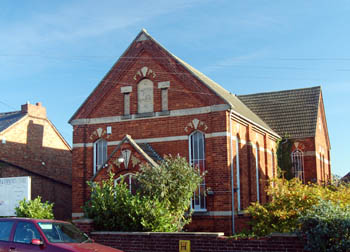Kempston Independents and Bunyan Meeting

The former Bunyan Meeting September 2007
Independents were exactly what their name suggests, a group of nonconformists who believed in the independence of each meeting. They often associated with the Baptists and later came to be known as Congregationalists.
Edwin Welch researched the history of registrations in Bedfordshire for Bedfordshire Historical Records Society Volume 75 Bedfordshire Chapels and Meeting Houses [published in 1996] and found two registrations for meetings by Independents. The first, which is also the first known registration of any meeting in Kempston, was on 1st May 1672 when the house of John Baxter was registered for worship.
Visitations by the Bishop of Lincoln to Bedfordshire in the early 18th century give some idea as to the number of nonconformists in each parish from returns made by the vicar or rector. Former County Archivist Patricia Bell has compiled returns from 1706 to 1720 for the Bedfordshire Historical Records Society (Volume 81, published 2002). The returns for Kempston consistently noted a sizable number of Independents: there were twenty seven families (about 13 to 15% of the total number in the parish) recorded in 1706, 1709 and 1712. The return for 1717 did not quote a figure but noted that all dissenters accounted for about thirty families. The total is put at thirty to forty families in 1720.
The vicar noted in 1706 “There was a Meeting house in the parish, but now it is not used” presumably referring to the meeting registered in 1672. referring to Independents in 1709 he stated: “These last sometimes meet here, but they commonly go to Bedford”.
In the summer of 1812 a “newly erected building in Giles Close belonging to John Joice of Kempston” was registered by Joice himself, James Smith and William Dugliss [ABN1/1, ABN2/145]. It seems as if this is the meeting referred to below. Giles Close, identified on the
Inclosure map for Kempston of 1804 [MA18/1] was in the area on the south side of Kempston High Street today [2013] roughly marked by Guilas Close.
On Sunday 30th March 1851 a census of all churches, chapels and preaching-houses of every denomination was undertaken in England and Wales. The local results were published by Bedfordshire Historical Records Society in 1975 as Volume 54, edited by D. W. Bushby. A return for the Independent Meeting in Kempston was filled out by the manager, John Joyce, probably the same man as noted above in 1812.
Joyce noted that the chapel dated from 1815 (perhaps a mistake of memory for 1812) and that all sittings were free. In the morning there were 100 Sunday scholars and 100 in the afternoon. In the evening the congregation had been about one hundred. Joyce wrote: “Independent Chapel, Kempston used as a School Room morning and afternoon. No. of children 110. Preaching by Local Preachers in the evening, general congregation 100”.
As we have seen the independents were later known as the Congregationalists. One of the Bedfordshire churches making up the Congregationalist fellowship was, and is, the Bunyan Meeting. In 1860 a Congregational chapel in Kempston, which was “connected with Bunyan Meeting, Bedford” was registered by John Jukes of Dame Alice Street, Bedford, the senior Congregational minister. It is not clear where this meeting was but it may have taken over from the early 19th century meeting in Kempston High Street either on the same site or a different one. By the time of the 1st edition Ordnance Survey map of 1884 there was no chapel on the High Street site (having been replaced, presumably, by the 1871 chapel detailed below).
A new chapel opened in Up End, in what became Bunyan Road, on 21st October 1871 [BY16/5/1] and was registered in 1892 by James Coombs of Bedford, a trustee. The building was licensed for marriages the same day. This building is now Bunyan Road Christian Fellowship, a branch of the Church of God Project which reaches out particularly to the African-Caribbean community.